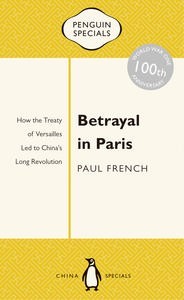Posted: May 30th, 2014 | No Comments »
Alex Monro’s (an old Shanghailander himself of recent vintage) The Paper Trail is now out….
The story of how a Chinese invention has wrapped itself around our world,
with history’s most momentous ideas etched upon its surface
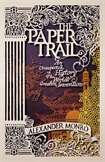
Â
Â
It can be eaten as rice paper or it can carry regurgitated food as an airplane sick bag. Paper can cover a spot and it can cut a finger. Children have made handheld aeroplanes out of it and assassins have moistened it to block a sleeping victim’s nostrils before strangulation. It can last for hundreds of years but it can also disappear with moisture in minutes or be eaten by bookworms in a few days. It can be as mundane and practical as a bus ticket or it can be as prized and expensive as the interface of the world’s greatest paintings.
Â
The Paper Trail tells the story of how a simple Chinese product has for two millennia allowed knowledge, ideas and religions to spread at an unprecedented rate around the world.
Â
Alex Monro traces this groundbreaking invention’s voyage, beginning with the Buddhist translators responsible for its spread across China and Japan, and follows it westward along the Silk Road, where it eventually became the surface of the Quran.
Â
Once paper reached Europe, it became indispensable to the scholars who manufactured the Renaissance and Reformation from their desks. As Monro uncovers, paper created a world in which free thinking could flourish, and brought disciplines from science to music into a new age.
Â
Alex Monro studied Chinese at the University of Cambridge and in Beijing before working for The Times in London and for Reuters in Shanghai. He has contributed chapters to The Dragon Throne (a history of China’s dynasties) and The Seventy Great Journeys in History, and edited two travel poetry anthologies, including China: City and Exile.
Â
In 2011, he won the Royal Society of Literature’s Jerwood Award for Non-Fiction for The Paper Trail. He lives with his wife in the Cotswolds, and writes on contemporary China.
Posted: May 29th, 2014 | 1 Comment »
Jacques Deval (who’s real name was Jacques Boularan) was a French writer, playwright and director born in 1875. His is perhaps now best remembered for his play Tovaritch that became a 1937 film of the same name starring Claudette Colbert and Charles Boyer, a classic tale of White Russians fled to Paris.
However Boularan/Deval also wrote a journal of his trip to the Far East entitled Rives Pacifiques (Pacific Rivers, I guess, though to my knowledge it’s never been translated into English), published by Gallimard in 1937. Therefore Deval straddles two interests of mine – Paris and Asia in the 1930s.

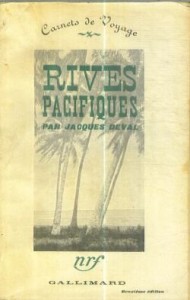
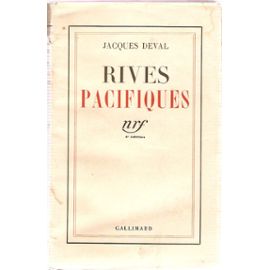
Posted: May 28th, 2014 | 2 Comments »
I’ve blogged previously about the Shanghai Restaurant, food Emporium and related branded cookbook from 1936 (nothing new in publishing!) that once stood on Soho’s Greek Street. In 1932 The Queenslander newspaper, surveying London’s Chinese restaurant scene wrote, “The “Shanghai†is much frequented by literary types, and has been “mentioned more than once in the public prints.†Only the old archway of the Manette Street hostelry divides the Shanghai restaurant from the large provision shop recently opened under the same management. Taking the very narrow path through the old archway, and turning to the right, we are upon another Canton restaurant, occupying a large first floor in Charing Cross Road. This is the only restaurant in London that reminds us of the hundreds of similar establishments in America, where one has a choice of over 600 Chinese restaurants in New York City alone.”
Here then is Greek Street in 1932 with the Chinese restaurant cluster poking in on the far left…..
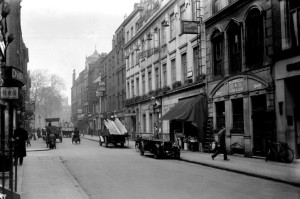
Posted: May 28th, 2014 | No Comments »
Rana Mitter’s history of China during the Second World War is now out in paperback….
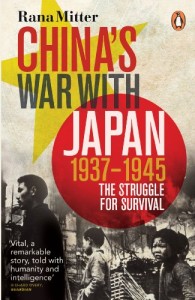
Different countries give different opening dates for the period of the Second World War, but perhaps the most compelling is 1937, when the ‘Marco Polo Bridge Incident’ plunged China and Japan into a conflict of extraordinary duration and ferocity – a war which would result in many millions of deaths and completely reshape East Asia in ways which we continue to confront today.
With great vividness and narrative drive Rana Mitter’s book draws on a huge range of new sources to recreate this terrible conflict. He writes both about the major leaders (Chiang Kaishek, Mao Zedong and Wang Jingwei) and about the ordinary people swept up by terrible times. Mitter puts at the heart of our understanding of the Second World War that it was Japan’s failure to defeat China which was the key dynamic for what happened in Asia.
Posted: May 27th, 2014 | No Comments »
A new history of The Taiping Heavenly Kingdom from Thomas Reilly…..
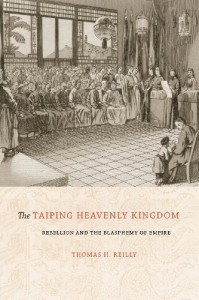
Occupying much of imperial China’s Yangzi River heartland and costing more than twenty million lives, the Taiping Rebellion (1851-64) was no ordinary peasant revolt. What most distinguished this dramatic upheaval from earlier rebellions were the spiritual beliefs of the rebels. The core of the Taiping faith focused on the belief that Shangdi, the high God of classical China, had chosen the Taiping leader, Hong Xiuquan, to establish his Heavenly Kingdom on Earth.
How were the Taiping rebels, professing this new creed, able to mount their rebellion and recruit multitudes of followers in their sweep through the empire? Thomas Reilly argues that the Taiping faith, although kindled by Protestant sources, developed into a dynamic new Chinese religion whose conception of its sovereign deity challenged the legitimacy of the Chinese empire. The Taiping rebels denounced the divine pretensions of the imperial title and the sacred character of the imperial office as blasphemous usurpations of Shangdi’s title and position. In place of the imperial institution, the rebels called for restoration of the classical system of kingship. Previous rebellions had declared their contemporary dynasties corrupt and therefore in need of revival; the Taiping, by contrast, branded the entire imperial order blasphemous and in need of replacement.
In this study, Reilly emphasizes the Christian elements of the Taiping faith, showing how Protestant missionaries built on earlier Catholic efforts to translate Christianity into a Chinese idiom. Prior studies of the rebellion have failed to appreciate how Hong Xiuquan’s interpretation of Christianity connected the Taiping faith to an imperial Chinese cultural and religious context. The Taiping Heavenly Kingdom shows how the Bible – in particular, a Chinese translation of the Old Testament – profoundly influenced Hong and his followers, leading them to understand the first three of the Ten Commandments as an indictment of the imperial order. The rebels thus sought to destroy imperial culture along with its institutions and Confucian underpinnings, all of which they regarded as blasphemous. Strongly iconoclastic, the Taiping followers smashed religious statues and imperially approved icons throughout the lands they conquered. By such actions the Taiping Rebellion transformed – at least for its followers but to some extent for all Chinese – how Chinese people thought about religion, the imperial title and office, and the entire traditional imperial and Confucian order.
This book makes a major contribution to the study of the Taiping Rebellion and to our understanding of the ideology of both the rebels and the traditional imperial order they opposed. It will appeal to scholars in the fields of Chinese history, religion, and culture and of Christian theology and church history.
Thomas H. Reilly is assistant professor of Chinese history and Asian studies at Pepperdine University
Posted: May 27th, 2014 | No Comments »
Of course 2014 is the centenary of the start of World War One (and I don’t need to plug the Penguin China WW1-China series of e-books again surely – but, oh well, here we go) and of course 110 years since the start of the Russo-Japanese War (which I’ve blogged about here). One other anniversary comes in October – that of the bizarre Dogger Bank Incident – never heard of it? Here’s what strangely happened…..
The Dogger Bank incident (also known as the North Sea Incident, the Russian Outrage or the Incident of Hull) occurred on the night of 21/22 October 1904, when the Russian Baltic Fleet mistook some British fishing boats in the Dogger Bank area of the North Sea for the Imperial Japanese Navy (rather a long way from home!) and fired on them. Russian warships also fired on each other in the chaos of the melée.. Three British fishermen died and a number were wounded. One sailor and a priest aboard a Russian cruiser caught in the crossfire were also killed. The incident almost led to war between Britain and Russia. Seems the Russian ships were steaming through the North Sea to eventually get to Port Arthur to fight the Japanese. Thinking the Japanese Navy had found out about this and decided to steam to the North Sea first for a sneak attack they got jittery and sunk some British fishing smacks!
Quite a bizarre story and a weird bit of naval history and an odd footnote to the Russo-Japanese War….More on Wikipedia here
For those who like anniversaries, and naval history, the Dogger Bank incident happened on the 99th anniversary of Nelson’s victory at Trafalgar

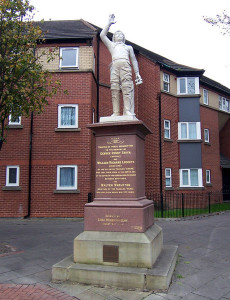 A statue erected in Hull (the British fishermen’s home port) by public subscription to the memory of George Henry Smith (skipper) and William Richard Legget (third hand), of the steam-trawler CRANE, who lost their lives through the action of the Russian Baltic Fleet in the North Sea, 22 October 1904, and Walter Whelpton, skipper of the trawler MINO, who died through shock, May 1905.
A statue erected in Hull (the British fishermen’s home port) by public subscription to the memory of George Henry Smith (skipper) and William Richard Legget (third hand), of the steam-trawler CRANE, who lost their lives through the action of the Russian Baltic Fleet in the North Sea, 22 October 1904, and Walter Whelpton, skipper of the trawler MINO, who died through shock, May 1905.
Posted: May 25th, 2014 | No Comments »
An excellent little exhibition of photographs of Liverpool’s Chinese community is running at the moment at the city’s Open Eye Gallery. The most interesting (to ChinaRhymers anyway) will be the Bert Hardy photographs from 1942 that were a commission for Picture Post (a couple below). However, the feature never ran so they’ve not been widely seen before. More on the exhibition here…
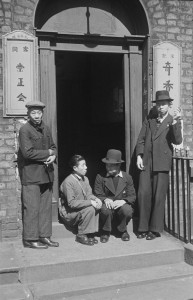
Chinese seamen outside a hostel in Liverpool, 1942
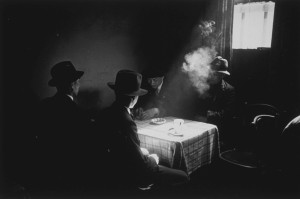
The Shanghai Restaurant on Liverpool’s Nelson Street in 1942
Ebb and Flow is an audio, visual survey of the history and changes that have taken place within the oldest Chinese community in Europe, curated by Jill Carruthers.
Drawing from the rich selection of photographic prints preserved in the Open Eye Gallery Archive, the show looks at the physical and architectural transformations of Liverpool’s Chinatown, as well as documenting the establishment and development of the local Chinese community.
Included in the show are works by Bert Hardy who photographed the Chinese seamen that came to the city from Shanghai on the Blue Funnel Shipping Company vessels in 1940s. He recorded their lives, living conditions and recreation as well as Liverpool at the time.
Four decades on and the Chinese community was well established in a new area of Liverpool, relocated to Nelson Street, after the May Blitz during WWII. British photographer Martin Parr documented Chinatown in the 80’s, exploring the restaurants, hair salons, Chinese supermarkets and community centers that were popular at the time.
Alongside these historical images, this exhibition also includes two contemporary works exploring the Chinatown that Liverpool is home to now.
Liverpool based artist duo John Campbell & Moira Kenny, The Sound Agents, have been funded by Heritage Lottery Fund to record Liverpool Chinatown Oral History, creating an audio visual digital archive of interviews, personal documents and photographs.
UK based photographer Jamie Lau has been commissioned to create a new body of work, looking at the Chinese community as it is now. Lau will visually explore the notion of being isolated in a city full of people, where human interaction may only happen on a base level, passing each other in the street, in shops and restaurants, like ships in the night.
Posted: May 23rd, 2014 | No Comments »
#10 -Â
Lou Tseng-tsiang (Lu Zhengxiang),who officially led the Chinese delegation to Paris, subsequently left the diplomatic service and became titular abbot of the Abbey of St. Peter in Ghent and met Tintin creator Hergé….Betrayal in Paris now on Amazon UK and Amazon US….
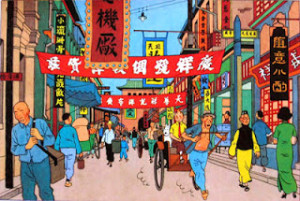
In the 1930s Lou, a long time Catholic, was based at a monastery in Loppen and became friendly with a young man by the name of George Remi, better known to the world as the cartoonist Hergé, the creator of Tintin. These early contacts by Hergé with Lou, and some other Chinese, meant Hergé developed a deep interest in China. See, Harry Thompson, Tintin: Hergé and his Creation, (London: John Murray, 2011).
